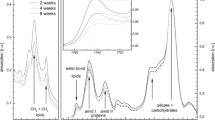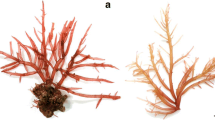Abstract
In coastal waters, Antarctic rhodophytes are exposed to harsh environmental conditions throughout the year, like low water temperatures ranging from −1.8°C to 2°C and high light during the summer season. Photosynthetic performance under these conditions may be affected by slowed down enzymatic reactions and the increased generation of reactive oxygen species. The consequence might be a chronic photoinhibition of photosynthetic primary reactions related to increased fragmentation of the D1 reaction centre protein in photosystem II. It is hypothesized that changes in lipid composition of biomembranes may represent an adaptive trait to maintain D1 turnover in response to temperature variation. The interactive effects of high light and low temperature were studied on an endemic Antarctic red alga, Palmaria decipiens, sampled from two shore levels, intertidal and subtidal, and exposed to mesocosm experiments using two levels of natural solar radiation and two different temperature regimes (2–5°C and 5–10°C). During the experimental period of 23 days, maximum quantum yield of photosynthesis decreased in all treatments, with the intertidal specimens exposed at 5–10°C being most affected. On the pigment level, a decreasing ratio of phycobiliproteins to chlorophyll a was found in all treatments. A pronounced decrease in D1 protein concentration occurred in subtidal specimens exposed at 2–5°C. Marked changes in lipid composition, i.e. the ratio of saturated to unsaturated fatty acids, indicated an effective response of specimens to temperature change. Results provide new insights into mechanisms of stress adaptation in this key species of shallow Antarctic benthic communities.





Similar content being viewed by others
Abbreviations
- ANOVA:
-
Analysis of variance
- FA:
-
Fatty acid
- ETRmax:
-
Maximal electron transport rate
- Fv/Fm:
-
Maximum quantum yield
- PAR:
-
Photosynthetically active radiation
- PS II:
-
Photosystem II
- PI-curve:
-
Photosynthesis-irradiance curve
- PUFA:
-
Poly-unsaturated fatty acid
- UV radiation:
-
Ultraviolet radiation
References
Abele D, Ferreyra GA, Schloss I (1999) H2O2 accumulation from photochemical production and atmospheric wet deposition in Antarctic coastal and off-shore waters of Potter Cove, King George Island, South Shetland Islands. Antarct Sci 11:131–139
Aro EM, Virgin I, Andersson B (1993) Photoinhibition of photosystem II. Inactivation, protein damage and turnover. Biochim Biophys Acta 1143:113–134
Aro EM, Suorsa M, Rokka A, Allahverdiyeva Y, Paakkarinen V, Saleem A, Battchikova N, Rintamaki E (2005) Dynamics of photosystem II: a proteomic approach to thylakoid protein complexes. J Exp Bot 56:347–356
Beer S, Eshel A (1985) Determing phycoerythrin and phycocyanin concentrations in aqueous crude extracts of red algae. Aust J Mar Freshw Res 36:785–792
Bischof K, Hanelt D, Wiencke C (1998a) UV-radiation can affect depth-zonation of Antarctic macroalgae. Mar Biol 131:597–605
Bischof K, Hanelt D, Tüg H, Karsten U, Brouwer PEM, Wiencke C (1998b) Acclimation of brown algal photosynthesis to ultraviolet radiation in Arctic coastal waters (Spitsbergen, Norway). Polar Biol 206:388–395
Bischof K, Hanelt D, Wiencke C (1999) Acclimation of maximal quantum yield of photosynthesis in the brown alga Alaria esculenta under high light and UV radiation. Plant Biol 1:435–444
Bischof K, Hanelt D, Wiencke C (2000) Effects of ultraviolet radiation on photosynthesis and related enzyme reactions of marine macroalgae. Planta 211:555–562
Bischoff-Bäsmann B, Wiencke C (1996) Temperature requirements for growth and survival of Antarctic rhodophyta. J Phycol 32:525–535
Bruhn J, Gerard VA (1996) Photoinhibition and recovery of the kelp Laminaria saccharina at optimal and superoptimal temperatures. Mar Biol 125:639–648
Fahl K, Kattner G (1993) Lipid content and fatty acid composition of algal communities in sea-ice and water from the Weddell Sea (Antarctica). Polar Biol 13:405–409
Folch J, Lees M, Stanley GHS (1957) A simple method for the purification of total lipids from animal tissues. J Biol Chem 226:497–509
Gómez I, López-Figueroa F, Ulloa N, Morales V, Lovengreen C, Huovinen P, Hess S (2004) Patterns of photosynthesis in 18 species of intertidal macroalgae from southern Chile. Mar Ecol Prog Ser 270:103–116
Graeve M, Kattner G, Wiencke C, Karsten U (2002) Fatty acid composition of Arctic and Antarctic macroalgae: indicator of phylogenetic and trophic relationships. Mar Ecol Prog Ser 231:67–74
Gurr MI, Harwood JL, Frayn KN (2002) Lipid Biochemistry. Blackwells, Oxford
Guschina IA, Harwood JL (2006) Lipids and lipid metabolism in eukaryotic algae. Progr Lipid Res 45:160–186
Hanelt D, Jaramillo MJ, Nultsch W, Senger S, Westermeier R (1994) Photoinhibition as a regulative mechanism of photosynthesis in marine algae of Antarctica. Ser Cient Inst Antart Chil 44:67–77
Hanelt D, Wiencke C, Nultsch W (1997a) Influence of UV radiation on the photosynthesis of Arctic macroalgae in the field. J Photochem Photobiol 38:40–47
Hanelt D, Melchersmann B, Wiencke C, Nultsch W (1997b) Effects of high light stress on photosynthesis of polar macroalgae in relation to depth distribution. Mar Ecol Prog Ser 149:255–266
Harwood JL (1994) Environmental factors effecting lipid metabolism. Prog Lipid Res 33:193–202
Harwood JL, Guschina IA (2009) The versatility of algae and their lipid metabolism. Biochi 91:679–684
Inskeep WP, Bloom PR (1985) Extinction coefficients of chlorophyll a and b in N, N-dimethylformamide and 80% acetone. Plant Physiol 77:483–485
Jassby AD, Platt R (1976) Mathematical formulation of the relationship between photosynthesis and light for phytoplankton. Limnol Oceanogr 21:540–541
Kattner G, Fricke HSG (1986) Simple gas-liquid chromatographic method for the simultaneous determination of fatty acids and alcohols in wax esters of marine organisms. J Chromatogr 361:263–268
Kirst GO, Wiencke C (1995) Ecophysiology of polar algae. J Phycol 31:181–199
Leu E, Falk-Petersen S, Kwasniewski S, Wulff A, Edvardsen K, Hessen DO (2006) Fatty acid dynamics during the spring bloom in a High Arctic fjord: importance of abiotic factors versus community changes. Can J Fish Aquat Sci 63:2760–2779
Lüder UH, Knoetzel J, Wiencke C (2001) Acclimation of photosynthesis and pigments to seasonally changing light conditions in the endemic Antarctic red macroalga Palmaria decipiens. Polar Biol 24:598–603
Lüder UH, Wiencke C, Knoetzel J (2002) Acclimation of photosynthesis and pigments during and after six months of darkness in Palmaria decipiens (Rhodophyta): A study to simulate Antarctic winter sea ice cover. J Phycol 38:904–913
Murata U, Los DA (2007) Membrane fluidity and bemperature perception. Plant Phvsiol 115:875–879
Nelson MM, Phleger CF, Nichols PD (2002) Seasonal lipid composition in macroalgae of the northeastern Pacific ocean. Bot Mar 45:58–65
Osmond CB (1994) What is photoinhibition? Insights from comparisons of shade and sun plants. In: Baker NR, Bowyer JR (eds) Photoinhibition of photosynthesis from molecular mechanisms to the field. BIOS Scientific Publishers, Oxford, pp 1–24
Peterson ME, Daniel RM, Danson MJ, Eisenthal R (2007) The dependence of enzyme activity of temperature: determination and validation of parameters. Biochem J 402:331–337
Phleger CF (1991) Biochemical aspects of bouyancy in fishes. In: Hochachka PW, Mommsen TP (eds). Elsevier Science, Holland, pp 209–247
Quartino ML, Zaixso HE, Boraso de Zaixso AL (2005) Biological and environmental characterization of marine macroalgal assemblages in Potter Cove, South Shetland Islands, Antarctica. Bot Mar 48:187–197
Rautenberger R, Bischof K (2006) Impact of temperature on UV-susceptibility of two Ulva (Chlorophyta) species from Antarctic and Subantarctic regions. Polar Biol 29:988–996
Ricker RW (1987) Taxonomy and biogeography of macquarie Island seaweeds. British Museum (Natural History), London, pp 218–225
Sanina NM, Goncharova SN, Kostetsky EY (2004) Fatty acid composition of individual polar lipid classes from marine macrophytes. Phytochem 65:721–730
Schreiber U, Bilger W, Neubauer C (1994) Chlorophyll fluorescence as a non-intrusive indicator for rapid assessment of in vivo photosynthesis. In: Schulze E-D, Caldwell MM (eds) Ecophysiology of photosynthesis. Ecol Stud Anal Synth 100, pp 49–70
Sokal RR, Rohlf FJ (1995) Biometry – the principles and practice of statistics in biological research. Freeman, New York
Tevini M (1994) UV-B effects on terrestrial plants and aquatic organisms. Springer, Berlin, pp 175–190
Wiencke C (1990) Seasonality of red and green macroalgae from Antarctica–A long-term culture study under fluctuating Antarctic daylengths. Polar Biol 10:601–607
Wiencke C, Clayton MN (2002) Antarctic seaweeds. ARG Gantner Verlag KG, Ruggell, Lichtenstein, Synopses of the Antarctic benthos 9, 239 pp
Wiencke C, tom Dieck I (1989) Temperature requirements for growth and survival of macroalgae from Antarctica and southern Chile. Mar Ecol Prog Ser 59:157–170
Wiencke C, Bartsch I, Bischoff B, Peters AF, Breeman AM (1994) Temperature requirements and biogeography of Antarctic, Arctic and amphiequatorial seaweeds. Bot Mar 37:247–259
Wiencke C, Ferreyra G, Abele D, Marenssi S (2008) The Antarctic ecosystem of Potter Cove, King George Island (Isla 25 de Mayo) Synopsis of research performed 1999–2006 at the Dallmann Laboratory and Jubany Station. Rep Polar Mar Res 571:406
Acknowledgments
Funding by the Deutsche Forschungsgemeinschaft (DFG, Bi 772/7-1,2,3) is gratefully acknowledged. We are also thankful to Christian Wiencke as well as the AWI diving team for logistic support and sample supply. SB is grateful for Marie-Louise Kroon’s help during the Antarctic campaign. The study has been performed upon agreement for cooperation between the Dirección Nacional del Antárctico (Argentina) and the Alfred Wegener Institute (Germany).
Author information
Authors and Affiliations
Corresponding author
Rights and permissions
About this article
Cite this article
Becker, S., Graeve, M. & Bischof, K. Photosynthesis and lipid composition of the Antarctic endemic rhodophyte Palmaria decipiens: effects of changing light and temperature levels. Polar Biol 33, 945–955 (2010). https://doi.org/10.1007/s00300-010-0772-5
Received:
Revised:
Accepted:
Published:
Issue Date:
DOI: https://doi.org/10.1007/s00300-010-0772-5




